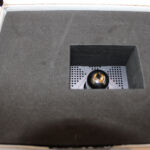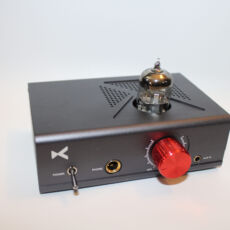Xduoo MT-601
disclaimer: The MT-601 was provided for the purpose of this review and the tube rolling article by Xduoo Audio. I have no financial interest in Xduoo or any of its distributors, nor did I receive any compensation beyond the product itself for this review. If you have an interest in purchasing any of the Xduoo amplifiers I have recently written about, I suggest you check out Xduoo’s website directly as they now offer direct sales. You can also follow them on Facebook for more information.
Unboxing / Packaging:
The packaging of the MT-601 is a new style for Xduoo with a very western retail look to the box. The front has the line drawing of the amp while the reverse has company info and some suggested uses but does not have even basic specs. Lifting the top of the box reveals the manual and then a couple of blocks of heavy foam. The top most block serves to protect the pre-installed tubes, while the lower block protects the 601 itself. Beneath the unit and foam protection is a box containing the power supply cable. One thing worth noting, if you get the MT-601 and 602 both like I did, the power supplies look identical, have the same sized barrel connector so will physically interchange, but are not cross-compatible as the 601 uses a 24V power supply while the 602 uses a 12V supply. Close inspection of the box on the power supply does show that the only difference in the two (externally) is the voltage label. With these in black lettering on a black surface they do not immediately leap out so marking them in some easily seen way as you unbox them may be a wise plan to keep from having problems later.
Build/Fit:
The case is anodized aluminum in a matte gray with removable end plates and rear plate. To remove the internals for cleaning or repair, only the rear plate needs to be removed as the internals no not attach to either side plate. The top of the case is vented well around the tube and the side plates also have a pattern of vents showing the Xduoo X. A single 6DJ8 type tube is used and protrudes a little less than an inch above the surface of the case. Inputs are a 3.5mm jack on the right front and a pair of RCA jacks on the rear. Outputs are a 6.3mm single ended output (a 6.3 to 3.5 adapter is provided) on the front face, and a line out provided by a pair of RCA jacks on the rear of the unit. The line-out is volume controlled so the unit can be used to introduce some tube coloration and volume control to powered monitors. This is purely an amplifier so no usb, optical, or coax connectors are needed and the only other features not covered yet are a large red volume knob immediately in front of the tube and a 24V DC input on the rear of the unit. Overall the unit stands a little over 1.5 inches tall (excluding the tube) , about 5 inches long and a little over 3 inches deep. The unit weighs slightly less than a lbs as well so is quite compact and comparable to the Schiit Magni or Modi in size and heft.
Internals:
The 601 uses the 6DJ8 tube (also known as a 6N11 (Chinese designation) and E88CC (Euro designation) as the pre-amp stage followed by a class-A buffer stage for power. Capacitors in the buffer stage are either Elna Silmic or Rubycon branded while the buffers themselves are a pair of IRF630N mosfets. The mosfets can be seen in the photo of the board’s top-side attached to the large heatsink. Those interested in the IRF630N can find the datasheet for it here. This combination of tube pre-amp and mosfet power amp circuits give the 601 a high gain of +18dB with a power output of 200mW into a 32Ω load. Xduoo lists the 601 as suitable with pretty much all headphones from 16-600Ω but output power does drop off pretty steeply above about 150Ω loads. SNR is respectable at better than 100dB and THD+N is listed as <.01 at 1kHz using a 32Ω load. I’ll write up some tube rolling experiments later but for now know that the 6DJ8/6922 series of tubes offers a myriad of options for any budget and was a good choice to allow users to customize to their liking.
Sound:
Normally the goal of an amp is to be gain on the wire and nothing else, but when we introduce a tube pre, it almost always has an impact on the signal in an audible way. So here we can talk about coloration as not only expected but welcomed. Those who want to avoid such coloration of the sound will likely opt for one of the many solid state amps that are available instead anyway.
The 6DJ8/6922 tube series offers a ton of options from the Telefunken that offers a very linear signature with little “tube” sound to others that offer very distinct increases in mids or top end. The 601 benefits from this and allows the user a wide variety of options for adjusting the tone as desired. It is hard to suggest any single tube that is best as it will depend on the headphone or speaker in use and the goals of the user. What I did find in comparing the MT-601 to something like the Magni3 (not fair as the magni has a ton more output power) is that it does convey some warmth and a bit of weight to the signature that is not there when using a solid state buffer alone. I am working on a tube rolling article and will have more to add later to this conversation. For now, the 6DJ8/6922 family gives the user enough options that one of them is bound to give the desired tone and a good all-around option is the GE 6DJ8 Black Glass bottle.
I’ll post a link to the tube rolling articles in this space once completed.
Thoughts / Conclusion:
The MT-601 is a tough review for me as in many ways I like the little guy, but in others it leaves me scratching my head a bit. Build quality is very good and I appreciate the external power supply rather than adding extra heat and space to the package that sits on the desk. Aesthetically it is a good looking little device, and sound wise it puts out a very pleasing tonality. The down side is the limited power output makes it best thought of as a tube pre-amp with a headphone output and I think it would have been better if the jack on the front of the unit had been a 3.5mm as it more realistically represents the intended headphones and earphones for use with the MT-601. As impedance goes up and sensitivities go down, the MT-601 is quickly overwhelmed and it is best to limit its use to 150Ω or less headphones and those with fairly high sensitivity as they get close to that 150Ω mark. Within those limits, I like the device and I think many will find a place for it on their desk as a tube pre-amp for powered speakers or for use with iems or something like the Beyer T5p or Meze 99 Classics. For harder to drive models like the Fostex T50rp variants or some of the higher impedance dynamics, its bigger brother the MT-602 is worth the additional $10 spend.
Summary
Pros: Well made, lots of tube options, pre-amp function works well
Cons: limited output power, best reserved for <150Ω or high sensitivity headphones















